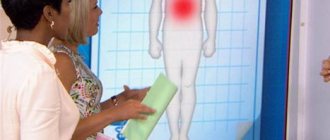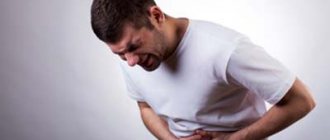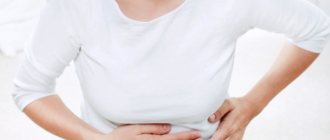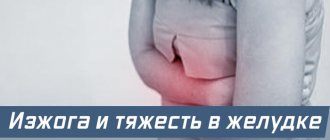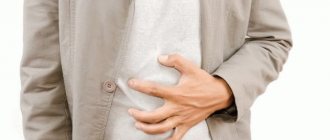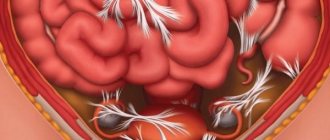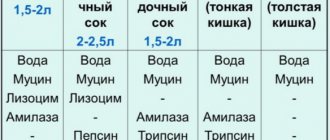Very often, with various diseases, pain does not have a clear localization; for example, the stomach and back may hurt at the same time. Stomach pain that radiates to the back is often perceived by people as a manifestation of osteochondrosis or heart disease, a heart attack.
But this may also indicate pathologies or diseases of the gastrointestinal tract, such as cholecystitis, ulcers, etc. In any case, pain is an alarming signal and you should consult a doctor.
Back pain, stomach pain, types and causes of pain
Pain in the stomach and back can be of different types, which may indicate completely different diseases. The pain can be sharp, stabbing or dull.
The main causes of stomach and back pain:
- stomach ulcer, perforated ulcer;
- acute pancreatitis;
- cholecystitis;
- hepatic colic;
- myocardial infarction;
- oncological diseases.
Peptic ulcer
With a stomach ulcer, acute pain occurs in the abdominal area, radiates to the back and is often localized on the left in the scapula or lower back, similar to pain in the kidneys. The pain mainly appears on an empty stomach , after excessive physical exertion, or after a meal, spicy or fatty.
Important : the pain is significantly reduced if you take a lying position and pull your legs towards your stomach, bending your knees. Other symptoms of exacerbation of peptic ulcer disease are heartburn and nausea. In this case, you should immediately consult a doctor so that he can prescribe comprehensive treatment - anti-inflammatory drugs and diet.
With a perforated gastric ulcer, a sharp, acute, unbearable pain appears in the stomach, spreading to the entire abdominal cavity and shoulder blades; it is difficult for the patient to move, he tries to breathe shallowly so as not to increase the pain. Occurs both on an empty stomach and after eating. These symptoms require urgent hospitalization; treatment often requires surgical intervention.
Until the ambulance arrives, the patient cannot eat, drink, or move independently; rest is necessary . The main risk factors for the development of gastric ulcer are:
- smoking, alcohol abuse;
- hereditary predisposition to stomach ulcers, genetically determined increased acidity of gastric juice;
- neuroses, depressive states, distress, chronic fatigue syndrome, emotional burnout and other psychologically determined factors;
- chronic gastritis, which, if not treated in a timely manner, can transform into an ulcer;
- improper diet: hunger, overeating, regular consumption of excessively spicy, fatty and sweet foods;
- taking medications that act aggressively on the gastric mucosa.
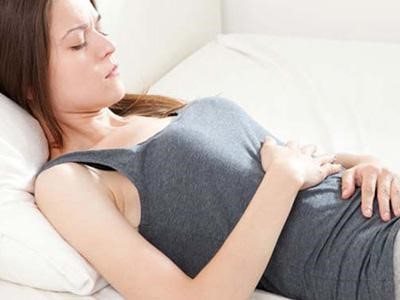
First aid for exacerbation of ulcers:
- bed rest,
- peace;
- don't drink water
- do not eat;
- in case of severe pain, it is permissible to use up to 0.5% novocaine solution orally;
- Place a cold compress on the stomach area.
Basic methods for diagnosing stomach ulcers:
- gastroscopy (examination of the stomach using an endoscope);
- X-ray;
- bacterial culture (detection of pathogenic bacteria and microorganisms);
- PCR (polymerase chain reaction) and ELISA (enzyme-linked immunosorbent assay) - tests for identifying Helicobacter;
- blood test (general and biochemical);
- stool analysis (to detect hidden bleeding).
Treatment of gastric ulcer consists primarily of following a strict diet prescribed by your doctor;
drug treatment - therapy with proton pump inhibitors to suppress gastric secretion; surgical intervention using the vagotomy method (in severe advanced forms).
Hepatic colic
Sharp pain in the abdomen and back, radiating to the right - never left - side, may indicate the development of hepatic colic. The sensations appear suddenly without previous symptoms and can last several minutes/hours or several days.
Why does my stomach hurt and radiate to my back?
- spread of pain to the area of the collarbone, scapula and neck;
- increased pain when trying to make any movement;
- bouts of vomiting, which also cause pain in the abdomen;
- increased sweating;
- chills;
- pale skin;
- wave-like pain developing in the area of the right hypochondrium;
- bloating, high tone of the abdominal muscle corset;
- abdominal pain on palpation;
- change in color of stool and urine.
We suggest you read: Portal vein 10 mm is normal • How to cure hypertension
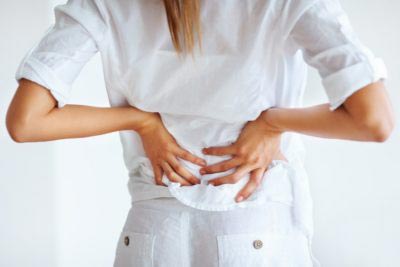
The appearance of symptoms of hepatic colic requires immediate medical attention. After the onset of an attack, it is highly recommended not to drink liquids or eat food. It is prohibited to use any medications for pain relief until doctors arrive.
Kinds
With gastrointestinal diseases, a person experiences different types of pain: girdles, dull, cutting, pulling. Also, negative symptoms can be constant and paroxysmal.
Shingles
Girdle pain usually accompanies pancreatitis and pancreatic necrosis. This is a dangerous disease of the pancreas, in which the tissue of the organ first becomes inflamed and then destroyed . The acute stage of pancreatitis is characterized by cutting girdle pain, bloating, and fever. The pain does not go away from changing body position. In the chronic stage, the patient experiences dull pain periodically, especially after eating.
Another cause of girdle pain is gallstone disease. Stones get stuck in the bile ducts, causing an attack of hepatic colic. The patient experiences a cutting pain that makes it difficult to move and even breathe. This condition is very dangerous and requires emergency surgery.
Acute
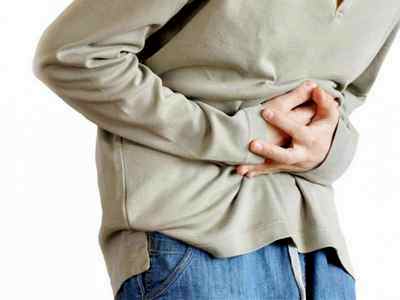
Acute pain occurs during the acute stage of the disease. The causes of acute pain syndrome are:
- stomach ulcer in the acute stage;
- acute cholecystitis;
- pancreatitis;
- acute gastritis;
- oncology stage 4.
Diseases can be differentiated by accompanying symptoms. For example, with ulcers and gastritis, pain radiates to the back between the shoulder blades . The patient also has: heartburn, belching, unpleasant taste in the mouth, nausea. Symptoms are somewhat relieved after eating. If the ulcer is perforated, then the patient’s abdominal muscles are very tense (acute abdomen), the pressure drops and bleeding from the throat may begin.
With cholecystitis and pancreatitis, abdominal bloating, increased temperature, increased heart rate, and increased sweating are observed.
Dumb
Dull pain is a sign of a chronic process . It appears in chronic cholecystitis, gastritis, pancreatitis. In this case, the patient experiences slight discomfort in the stomach, heartburn, if he has eaten rough or fatty foods.
Dull pain throughout the abdomen may be a sign of incipient appendicitis. Gradually the symptoms increase, the patient's condition worsens. Also, similar sensations persist after poisoning, when bacteria disrupt the normal microflora of the gastrointestinal tract.
Pulling
Nagging pain occurs with cholecystitis. When the gallbladder is inflamed, the normal flow of bile is disrupted. A person feels heaviness in the hypochondrium, the sensation resembles a sprained ligament.
Reference . Often, nagging pain in the hypochondrium appears after playing sports, for example, after a fast run. This is normal and is due to increased blood flow in the liver. After some time, everything is restored and the unpleasant sensations disappear.
Constant
Constant pain is an alarming symptom. Its most harmless cause is osteochondrosis of the thoracic region. In this case, pain from the spine radiates to the stomach area. In all other cases, urgent consultation with a doctor is required. Typically, such sensations indicate an increasing inflammatory or purulent process in the digestive organs . It can be triggered by a stone stuck in the duct, developing pencreatic necrosis, or colitis.
In patients with stage 4 cancer, pain is also constant. In this case, the patient sharply loses weight, appetite, and general exhaustion of the body occurs.
Perforation of the ulcer
Can my stomach and back hurt for other reasons? Severe pain, also felt in the back, may be a sign of a perforation (breakthrough) of a stomach or duodenal ulcer. The pain that accompanies it is described as dagger-like and intensifies with any attempt by the patient to make a full entrance.
We invite you to familiarize yourself with the lump near the spine between the shoulder blades
The localization of painful sensations is the umbilical region and the abdominal area on the right: right hypochondrium/side. Sometimes pain occurs, radiating to the right collarbone and shoulder. A typical sign of perforation of an ulcer is the tone of the abdominal muscles: the stomach becomes hard and flat like a wooden board.
The characteristic signs of a perforated ulcer are: some relief of pain after eating; after an attack of vomiting, the condition of the sick person improves only slightly. Treatment of the disease is only possible through surgery.
First aid for acute pain
Since most conditions accompanied by acute pain require immediate surgical treatment, you should not try to get rid of the pain on your own. It is forbidden to take analgesics, as this muffles the symptoms and does not stop the process . With a perforated ulcer or pancreatic necrosis, this is fraught with the development of peritonitis and sepsis. For the same reason, the patient should not be given food or drinks.
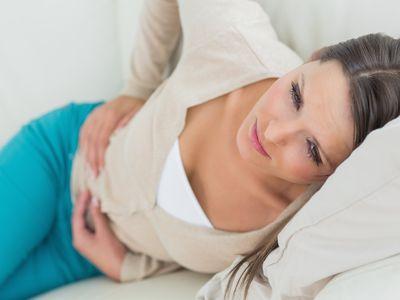
Algorithm for helping the patient before the ambulance arrives:
- Place the patient on the bed.
- Ensure air flow into the room: open the windows, remove the patient’s outer clothing.
- If possible, measure temperature, pulse and blood pressure.
- If vomiting or bleeding from the throat occurs, turn the patient on his or her side to prevent choking.
- Make sure that the patient is conscious and, if necessary, give ammonia to sniff.
Diagnostics
All gastrointestinal diseases have similar symptoms, so a comprehensive examination of the patient is required.
Diagnostics includes the following steps:
- Questioning the patient . The doctor finds out how long ago the symptoms appeared, what is the intensity and duration of the pain, and whether the person has chronic diseases.
- Blood and urine analysis . Both general and biochemical studies are carried out. An increase in leukocytes and ESR indicates an acute inflammatory process. Liver tests are done to study the functioning of the liver, bile, and pancreas.
- Fecal occult blood test . Be sure to prescribe for stomach ulcers, as there may be internal bleeding. This study reveals intestinal pathologies: Crohn's disease, diverticulitis.
- X-ray . This is an informative method for diagnosing gastric ulcers, oncology, and pancreatitis. X-rays are also prescribed if gallstone disease is suspected.
- CT, MRI These studies can detect even the slightest changes in organs. They detect tumors, stones, and liver dysfunction.
Can your stomach hurt from your spine?
Before you figure out what to do with radiating pain in the back and abdomen, you need to understand what diseases and causes cause this condition. More often, this can be done only after going to the hospital and undergoing tests. Since we can talk not only about a sprain, but also about an ulcer, heartburn after eating, epigastric pain or a serious pathology of internal organs. Doctors identify only 8 causes of stomach pain that radiates to the back.
Acute pancreatitis
Often severe, sharp pain in the lower back and abdomen indicates acute pancreatitis.
The main causes of the disease:
- Smoking and alcohol.
- Stones in the kidneys.
- Diabetes.
- Pregnancy.
- Obesity.
The main symptom is severe pain, which constantly intensifies; there is a feeling that the stomach and back are being tied with a belt.
Symptoms may also include:
- Nausea and vomiting.
- Swelling.
- Blue skin in the groin area.
- Yellowing of the entire skin.
- The pain radiates to the lower back, especially on the left.
Gastritis
Due to gastritis, the pain especially radiates to the lower back, aching and constant. Sometimes the syndrome becomes so strong that it is impossible to think. The main causes of the pathology are poor nutrition and the presence of the bacterium Helicobacter pylori.
In addition to pain radiating to the back, there may be other symptoms:
- Nausea and vomiting.
- Diarrhea.
- Weakness and fatigue.
- Heaviness and discomfort in the abdomen.
- Bad breath.
Spinal diseases are widespread in twenty-first century society. They are often accompanied by back pain, which prevents people of all ages from leading a normal lifestyle and limits their ability to carry out their daily activities. Wanting to get rid of this, they try to find a solution to the problem from a doctor.
It happens that pain does not come from the affected organs. Often the problem is in the spine: it is the source of pain and the root cause of discomfort.
People often note that discomfort appears not only in the back. They spread to other parts of the body. As a rule, they believe that if the spine hurts, then the stomach should also hurt.
As a result, problems arise in determining the origin of the pathology, since pain in the abdominal area is a symptom of many diseases. Whether your stomach hurts due to the spine or not - the attending physician will be able to answer this, and then only after a thorough examination.
When a doctor diagnoses a patient with the development of several diseases, he must pay special attention to determining the root cause of the problem.
In this article we will answer the question whether stomach pain can come from the spine. In addition, we will find out why this happens, as well as how to get rid of it.
Back pain can be either an independent ailment or a consequence of complications occurring in nearby organ systems and disruption of their functionality.
GERD, gastritis, ulcer
Gastritis is an acute or chronic inflammation of the mucous membrane of the stomach walls. Common causes of gastritis are constant stress, poor diet, infectious diseases (Helicobacter), and exposure to chemicals.
Symptoms:
- yellow coating on the tongue;
- taste of bile in the mouth;
- heartburn;
- localization of pain in the upper digestive tract.
Gastroesophageal reflux disease of the stomach is a pathological inflammatory process of the walls of the lower esophagus. Occurs as a result of regular entry of food particles from the duodenum into the esophagus, as a result of which gastric juice irritates the mucous walls.
Symptoms:
- constantly experiencing heartburn;
- belching after eating with a bile or sour taste;
- burning sensation in the solar plexus area.
Long-term constant pain often leads to stomach ulcers.
Gastric ulcer is a localized lesion of the stomach walls, characterized by regular relapses. Pain usually occurs after eating or on an empty stomach; often pain in the stomach “radiates” to the lower back.
The causes of stomach ulcers include nervous shock (shock), acute damage to other organs, complex operations, and renal failure.
Symptoms:
- stomach pain occurs immediately after eating;
- nausea, belching, bloating occurs;
- vomiting brings temporary relief (relieving heaviness in the stomach).
Appendicitis
Appendicitis is an inflammation of the appendage of the cecum.
The reasons that provoke the inflammatory process are: disruption of microflora (staphylococci, streptococci, anaerobic bacteria), stagnation of intestinal contents in the appendix, entry of foreign bodies into the appendix and, as a result, the spread of bacteria.
Signs of inflammation of the appendix:
- “Sharp” pain on the right side of the abdomen during exacerbation of appendicitis;
- Constantly experienced girdling pain around the navel can radiate to the lumbar area;
- The occurrence of nausea and vomiting;
- Diarrhea or, conversely, constipation;
- Tachycardia.
The location of the pain depends on the location of the appendix. Most often, the intensity of painful sensations manifests itself under the right rib, next to the liver.
There are cases when the vermiform appendix is located behind the cecum and wraps towards the kidney. In this case, the pain will manifest itself in the lower back and radiate to the lower extremities.
Acute pancreatitis
Pancreatitis is inflammation of the pancreas with further disruption of its secretory function. The development of pancreatitis is caused by an increase in the concentration of calcium ions in the blood, genetic predisposition, the use of medications (corticosteroids, estrogens, diuretics), cystic fibrosis (congenital tissue damage).
The acute phase of the inflammatory process is characterized by bloating, heartburn, vomiting, nausea; in humans, the skin and sclera acquire a yellow tint. “Sharp” pain of high intensity appears after eating fatty and spicy foods, also after drinking alcohol.
Exacerbation of chronic pancreatitis occurs for the following reasons:
- Cholelithiasis;
- Viral and bacterial infections of the body;
- Spicy, fried, fatty foods;
- Inflammatory diseases of the gastrointestinal tract.
If your stomach hurts while lying on your back, this indicates the development of various pathologies in the spine. These include thoracic and lumbar osteochondrosis. Due to the development of degenerative changes in this area, the intervertebral discs are displaced. This puts excessive pressure on the spine and surrounding areas. Also, pathologies in the spine lead to pinching of the nerve roots of the lower back. This causes both back and stomach pain.
Because of this, a person suffers from severe, acute pain in the stomach, which radiates to the spine. In addition, he suffers from heartburn, nausea followed by vomiting.
We suggest that you familiarize yourself with the composition of the gel horsepower for joints
The right approach to treatment
Therapy depends on the identified disease. Some conditions (perforated ulcers, stones, cancer) require surgery.

Other diseases are treated conservatively using the following drugs:
- Antibiotics. Necessary for exacerbation of ulcers, pancreatitis, cholecystitis.
- Enzymes. Prescribed to normalize digestion.
- Antispasmodics. Used to relieve muscle spasms of the stomach and intestines.
- Medicines that reduce the secretion of gastric juice.
- Probiotics.
- Reducing bloating.
- Antiemetics. Prescribed for severe attacks of nausea.
Diet
Diet is important in the treatment of gastrointestinal diseases. Without nutritional adjustments, all efforts will go down the drain. The acute stage of the disease requires a strict diet. The diet consists of liquid porridges with water, pureed soups, crackers, and baked potatoes. After the acute period is over, you can gradually add other dishes, avoiding fatty, fried, spicy and rough foods. All dishes can be steamed or baked. Take food in small portions, avoiding stomach overfilling. Alcohol and smoking are strictly prohibited.
Stomach pain radiating to the back occurs due to various diseases. They are usually associated with the digestive organs. These diseases quickly become chronic and periodically bother the patient. Therefore, it is important to diagnose the pathology at the initial stage, while a complete cure is still possible.



